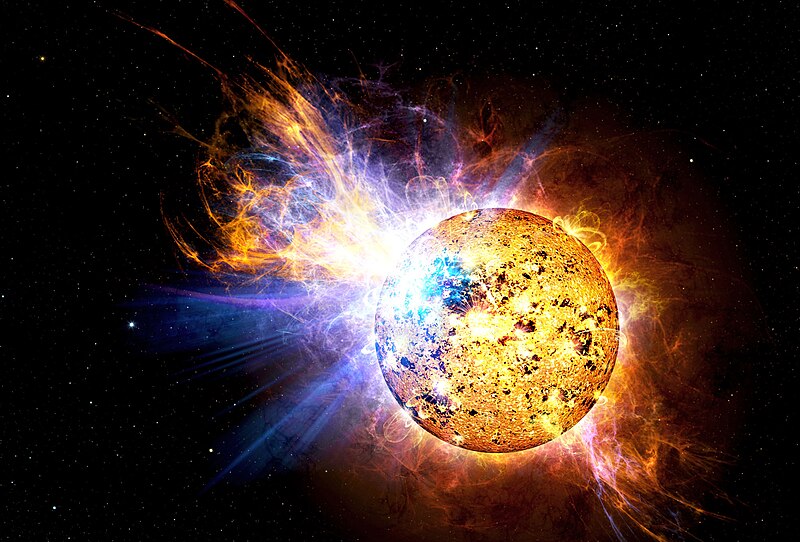Datei:Nasa EV Lacertae 250408.jpg

Originaldatei (2.000 × 1.355 Pixel, Dateigröße: 485 KB, MIME-Typ: image/jpeg)
Diese Datei stammt aus Wikimedia Commons und kann von anderen Projekten verwendet werden. Die Beschreibung von deren Dateibeschreibungsseite wird unten angezeigt.
|
Beschreibung
| BeschreibungNasa EV Lacertae 250408.jpg |
Explosión de EV Lacertae English: Featured image of NASA. Explosión de EV Lacertae: For many years scientists have known that our sun gives off powerful explosions, known as flares, that contain millions of times more energy than atomic bombs. But when astronomers compare flares from the sun to flares on other stars, the sun's flares lose. On April 25, 2008, NASA's Swift satellite picked up a record-setting flare from a star known as EV Lacertae. This flare was thousands of times more powerful than the greatest observed solar flare. But because EV Lacertae is much farther from Earth than the sun, the flare did not appear as bright as a solar flare. Still, it was the brightest flare ever seen from a star other than the sun. Español: Imágen destacada en la NASA: Durante muchos años, los científicos creían saber qué producía las poderosas explosiones, conocidas como llamaradas, que contienen millones de veces más energía que una bomba atómica. |
| Quelle | NASA Image of the Day Gallery |
| Urheber | Casey Reed/NASA |
Lizenz
| Public domainPublic domainfalsefalse |
| Diese Datei ist gemeinfrei (public domain), da sie von der NASA erstellt worden ist. Die NASA-Urheberrechtsrichtlinie besagt, dass „NASA-Material nicht durch Urheberrecht geschützt ist, wenn es nicht anders angegeben ist“. (NASA-Urheberrechtsrichtlinie-Seite oder JPL Image Use Policy). |  | |
 |
Warnung:
|
Dateiversionen
Klicke auf einen Zeitpunkt, um diese Version zu laden.
| Version vom | Vorschaubild | Maße | Benutzer | Kommentar | |
|---|---|---|---|---|---|
| aktuell | 07:32, 24. Okt. 2023 |  | 2.000 × 1.355 (485 KB) | wikimediacommons>Юрий Д.К. | original quality |
Dateiverwendung
Die folgenden 2 Seiten verwenden diese Datei:
Metadaten
Diese Datei enthält weitere Informationen, die in der Regel von der Digitalkamera oder dem verwendeten Scanner stammen. Durch nachträgliche Bearbeitung der Originaldatei können einige Details verändert worden sein.
| Breite | 3.311 px |
|---|---|
| Höhe | 2.243 px |
| Bits pro Farbkomponente |
|
| Art der Kompression | LZW |
| Pixelzusammensetzung | RGB |
| Kameraausrichtung | Normal |
| Anzahl Komponenten | 3 |
| Horizontale Auflösung | 300 dpi |
| Vertikale Auflösung | 300 dpi |
| Datenausrichtung | Grobformat |
| Software | Adobe Photoshop CS2 Windows |
| Speicherzeitpunkt | 10:19, 19. Mai 2008 |
| Farbraum | Nicht kalibriert |
| Bildbreite | 2.000 px |
| Bildhöhe | 1.355 px |
| Digitalisierungszeitpunkt | 06:19, 19. Mai 2008 |
| Datum zu dem die Metadaten letztmalig geändert wurden | 06:19, 19. Mai 2008 |
| IIM-Version | 2 |